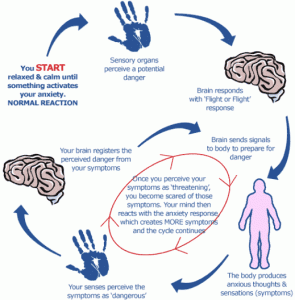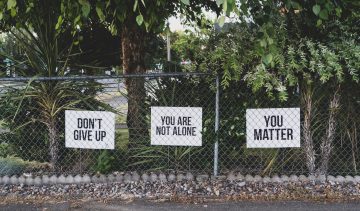Anxiety can be an unpleasant, uncomfortable, and sometimes scary experience. Nevertheless, it has the important job of protecting us from perceived danger and therefore is an emotion we all experience from time to time. What can happen, particularly if you are suffering from an anxiety disorder such as panic disorder and generalised anxiety disorder, is that you become anxious or fearful of the anxiety itself, leaving you stuck in a vicious cycle. In this article, I hope to clearly explain this cycle, how it emerges and explain some of the things you can do to break it.
Anxiety response
Anxiety is a normal psychological and physiological response humans have in reaction to a perceived threat. Its function is to prepare us to respond to threats and reduce potential harm.
Physical symptoms
Physical symptoms characteristic of anxiety preparing our body for ‘fight or flight’ can include:
- heartbeat racing
- sweating
- feeling tense
- feeling dizzy or light-headed
- increased breathing or hyperventilating.
Psychological and behavioural symptoms
There are also psychological and behavioural symptoms that occur as a result of anxiety that help us deal with the threat:
- You begin to engage in negative thinking (catastrophizing).
- You worry or ruminate about the potential threat. You try to come up with possible solutions.
- You will monitor and pay attention to the potential threat to avoid danger.
- You will try to control, remove or flee the threat.
When there is a real threat in our environment these responses can be very helpful in solving problems or minimising the danger. However, when the ‘threat’ is anxiety itself, these responses can lead to more harm than help and can lead to you feeling stuck in a vicious cycle. Take a look at the one illustrated below:

Sourche: the vicious anxiety cycle – medium.com
Anxiety resistance
In some cases you may begin to fear the anxiety itself; you experience anxiety about anxiety symptoms. This can e.g. be a result of not understanding anxiety properly because you have had a scary or negative experience with anxiety. Or because you experience anxiety frequently. For example, after suffering a panic attack which can be frightening and overwhelming, you can begin to fear the symptoms you’ve experienced during the anxiety or the panic attack.
Your brain then treats anxiety and anxiety symptoms as a ‘threat’. As a result, your brain and body respond accordingly:
- You begin to catastrophize and worry about the anxiety. For example, you may have thoughts such as ‘’all this anxiety is going to drive me crazy’’, ‘’I am going to experience a heart attack’’ or ‘’I am going to lose control’’. Leading to even more anxiety.
- You begin to monitor for anxiety and check whether you are experiencing any symptoms, putting all your attention on your symptoms.
- You try to control or get rid of anxiety. For example by avoiding situations which make you anxious or carrying out behaviour or rituals which make you feel safer. In this way, you do not learn that it is okay to experience anxiety.
- You may ruminate on what caused the anxiety and any future problems you may face because of the anxiety.
Unfortunately as a result of your anxious response to the anxiety and putting so much focus and effort on it, your anxiety only increases and it reinforces the idea that the anxiety is a ‘threat’. Your brain will treat it accordingly, leaving you stuck in a vicious cycle of anxiety about anxiety, only making things worse.
You can break the cycle!
To break the cycle you can teach your brain that anxiety is not a threat by changing the way you respond to anxiety. By your brain no longer viewing anxiety as a ‘threat’, it will eventually get used to the experience of anxiety (normal response), start filtering it out and get ‘bored’ of it. So what can you do?
- Challenge your negative or catastrophic thoughts about anxiety. Anxiety will not drive you crazy or kill you. You can try reassuring yourself with more neutral realistic thoughts.
- Exposure, exposure, exposure. By exposing yourself to anxiety, anxiety symptoms or scary situations, you slowly learn that anxiety does not harm you and that the tension eventually will decrease.
- Practise acceptance and letting go of control using Mindfulness. Paradoxically trying to control or avoid anxiety often has the effect of only making it worse, especially in the long run. Practising mindfulness can help you to be aware of your negative thoughts and emotions non-judgmentally and experience them for what they are.
Professional help
Do you experience fear of anxiety, or do you identify with the vicious cycle above? Professional support can make it easier to break through this cycle and practise the exercises above. See here for more information on treatment with NiceDay.











